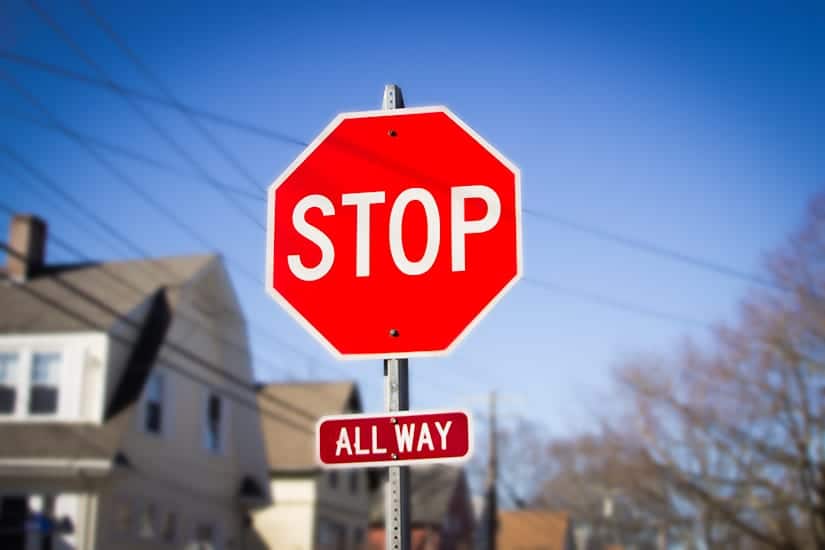You’re at a stop sign, and so are three other drivers. One of two things will happen: no one will make the first move to cross the intersection or — you guessed it! — everyone will try to go at once. Do you remember the proper right-of-way laws?

Most drivers have experienced a stop sign stand-off at some point while driving. Since most people on the road have not taken a driver’s education class for some time, we wanted to refresh your memory on the laws regarding stop signs and the right-of-way — being reminded of the rules of the road is a good way to lessen the chances that you’ll be involved in an avoidable car accident!
Stopping
According to the Virginia DMV, there are a number of circumstances in which you must stop your vehicle. Stopping is required by law at all stop signs, red traffic lights, and flashing red signals. And as for the question of who’s turn it is if cars arrive together at a 4-way stop sign, the answer is that the driver to the left must yield to the driver to the right!
Vehicles are also required to stop whenever they enter a street or are crossing over a sidewalk from a driveway, alley, building, or parking lot; at railroad crossings with flashing signals; when signaled by flaggers who are directing traffic; and for pedestrians attempting to cross the street at a crosswalk. This last required stop is especially important to remember, as pedestrians are particularly vulnerable if they were to be involved in any type of car accident.
Stopping Distance
Being aware of the distance and time it takes your vehicle to come to a stop after you apply the brakes is another important factor in keeping a potential car crash and subsequent injury at bay. Different driving factors and conditions affect how quickly a vehicle can stop, and keeping this in mind whenever you’re behind the wheel will help keep you safe.
The three overarching factors that determine the distance that it takes to stop your vehicle are perception time, reaction distance, and braking distance. Perception time is the time it takes you to recognize a hazard. Reaction distance is the distance your vehicle travels between the time you recognize a problem and the time you apply the brakes. And braking distance is the distance your car travels after you apply the brakes.
These three main stop-time factors can be affected by a number of different environmental influences, including the weather, what the visibility is like, and even your own mental and physical condition behind the wheel. Braking distance is also affected by how fast your vehicle is traveling, the condition of your brakes and tires, and the pavement condition. Believe it or not, wet pavement can double your braking distance!

Yielding the Right-of-Way
Another thing to keep in mind is that yield can also mean stop in certain situations. One of the most common examples of this is coming to a yield but finding that you cannot merge safely into the flow of traffic. If this is the case you must stop until there is a break in the flow of traffic and you can safely merge.
One of the most confusing — and potentially dangerous — right-of-way situations is when the traffic lights at an intersection are not working. If this happens to you, remember that all vehicles coming to the intersection must stop, and — as at any all-way stop — the driver on the left must yield to the driver on the right. In a situation where vehicles from different directions arrive at an intersection at different times, the vehicle that arrives first goes first.
There are a number of other examples of yielding the right-of-way that you might come across while out on the road. Roundabouts can sometimes feel a bit confusing or intimidating if they are not a part of your daily commute, but if you remember the simple rule that any time you enter a roundabout you must yield to traffic already in it, you’ll be able to navigate the traffic circle smoothly. Another situation where it is essential that you yield the right of way is anytime you encounter a pedestrian or bicyclist. You must yield to pedestrians or bicyclists who are crossing a street within a clearly marked crosswalk, or at an unmarked intersection. Vehicle turns on red can be especially hazardous to pedestrians, so pay particular attention in these situations and allow any people on foot or on bike to cross the street safely.
If you encounter a funeral procession or a military convoy, give them the right of way. You are required to yield to funeral processions, but unless there is a police escort, the lead vehicle in the procession must obey all traffic signs and signals. If you are part of the funeral procession, you are permitted to follow the lead vehicle carefully without stopping, and you can use your hazard lights to let other cars know that you are part of the procession.
Making sure that you know the rules of the road is a crucial component of avoiding accident and injury while you’re behind the wheel. Whether you’ve been driving for decades or are a new license-holder, it’s always a good idea to brush up on your car safety knowledge from time to time! Take a few moments to review the Virginia Driver’s Manual to help keep you and your loved ones safe and secure. And if you’ve ever been injured in a car accident, don’t hesitate to contact us here at Burnett & Williams. We’re always here to help.